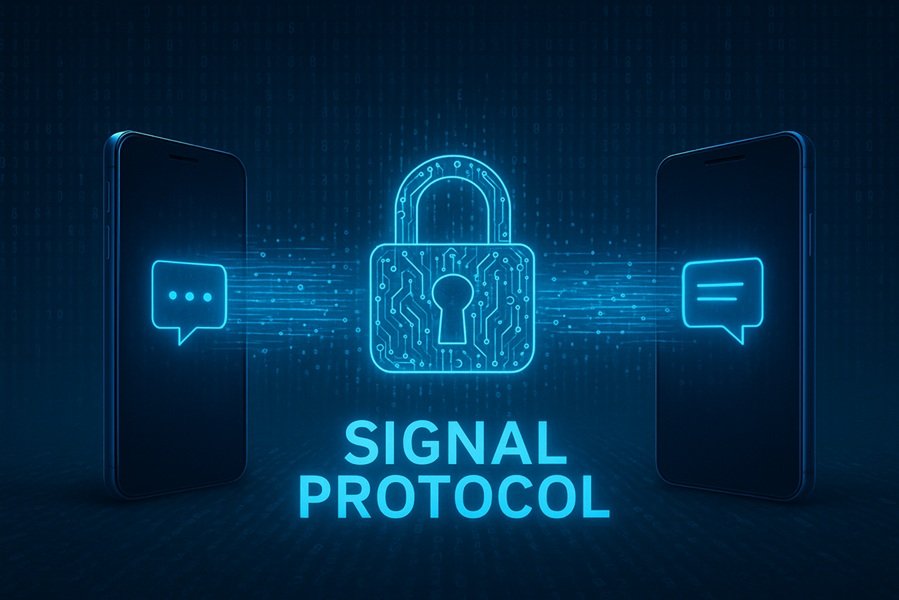
Introduction
In today’s digital age, privacy has become one of the most critical issues in communication. With constant concerns about data breaches, surveillance, and unauthorized access, the need for secure messaging systems has never been greater. The Signal Protocol, developed by Open Whisper Systems, stands at the forefront of this revolution — providing robust end-to-end encryption (E2EE) that underpins some of the world’s most widely used messaging apps, including Signal, WhatsApp, Messenger (Meta), Skype, and Google Messages.
But what exactly is the Signal Protocol? How does it ensure security, and what makes it more advanced than older encryption models? Let’s dive deep into its architecture, cryptographic mechanisms, and real-world applications.
What is Signal Protocol?
The Signal Protocol (formerly known as the Axolotl Ratchet) is a cryptographic protocol that enables end-to-end encrypted communication. It is designed to ensure that only the sender and recipient can read the message, even if the communication channels or servers are compromised.
Developed by Moxie Marlinspike and Trevor Perrin, the protocol combines a set of cryptographic techniques — including the Double Ratchet Algorithm, X3DH key agreement protocol, and Prekeys — to ensure forward secrecy and deniability.
In simpler terms:
Even if someone gets access to your encrypted messages today, they still won’t be able to decrypt past or future messages.
Core Principles of Signal Protocol
The Signal Protocol is built around three fundamental principles that make it unique:
1. End-to-End Encryption
Messages are encrypted on the sender’s device and only decrypted on the recipient’s device. Even the server that transmits the message cannot read its contents.
Read This: End-to-End Encryption (E2EE) in Messaging Apps — A deep, practical analysis
2. Forward Secrecy
Each message uses a unique encryption key. If a key is compromised, only that specific message can be decrypted — previous and future messages remain secure.
3. Post-Compromise Security
Even if an attacker temporarily gains access to your device or key, they can’t continue to eavesdrop once the device regains security. The protocol self-heals by constantly generating new session keys.
How Signal Protocol Works
Step 1: Key Exchange – X3DH (Extended Triple Diffie-Hellman)
Before users can exchange encrypted messages, they need to securely agree on shared keys. The X3DH protocol handles this initial handshake.
It uses:
- Identity Key (IK) – a long-term public key that identifies the user.
- Signed Prekey (SPK) – a medium-term key signed by the identity key.
- One-time Prekey (OPK) – disposable keys used once for added security.
When a user sends a message to someone for the first time, these prekeys are fetched from the server, and a shared secret is derived using multiple Diffie-Hellman (DH) key exchanges.
Step 2: Message Encryption – The Double Ratchet Algorithm
Once the initial shared secret is established, message encryption begins using the Double Ratchet Algorithm, which combines two key ratchets:
- Symmetric-key ratchet: Updates encryption keys for every new message.
- Diffie-Hellman ratchet: Generates new key pairs after receiving messages.
This combination ensures that each message has a unique encryption key — providing forward secrecy and post-compromise security.
Ratchet Example:
Suppose Alice and Bob are chatting.
Every time Alice sends a new message, the encryption key “ratchets” forward, ensuring old keys are discarded.
If an attacker somehow steals one key, it becomes useless for decrypting older or future messages.
Step 3: Message Authentication and Integrity
Each encrypted message also includes:
- A Message Authentication Code (MAC) — ensuring the data hasn’t been altered.
- A Header containing the sender’s ratchet public key, enabling the receiver to continue the secure conversation.
This ensures both authenticity and consistency in message flow.
Advanced Cryptographic Features
1. Forward Secrecy
Every message has a new key. Once a message is sent, its key is discarded — preventing decryption of past communications even if a device is compromised later.
2. Future Secrecy (Post-Compromise Security)
If an attacker briefly gains access to a user’s device, they can’t decrypt future messages, as new keys are constantly generated.
3. Deniability
Signal Protocol does not use digital signatures for every message. This means:
While you can prove you received a message, you cannot cryptographically prove who exactly sent it.
This design provides plausible deniability, crucial for private communication.
Comparison with Other Encryption Protocols
| Feature | Signal Protocol | PGP | OTR | TLS |
|---|---|---|---|---|
| Encryption Scope | End-to-end | Message-level | Chat sessions | Transport-level |
| Forward Secrecy | ✅ Yes | ❌ No | ✅ Yes | ✅ Yes |
| Post-Compromise Security | ✅ Yes | ❌ No | ❌ No | ❌ No |
| Deniability | ✅ Yes | ❌ No | ✅ Yes | ❌ No |
| Used In | Signal, WhatsApp, Messenger | Emails | Chat clients | HTTPS |
Signal stands out because it’s specifically built for continuous messaging, not just static file or email encryption.
Real-World Implementations
The Signal Protocol has become the de facto standard for secure messaging. Its open-source nature allows other platforms to integrate it freely.
1. Signal App
The original implementation, offering secure texts, calls, and group chats.
2. WhatsApp
Since 2016, WhatsApp (owned by Meta) has integrated the Signal Protocol for all private chats — protecting over 2 billion users globally.
3. Facebook Messenger (Secret Conversations)
Facebook introduced optional encrypted chats using the Signal Protocol.
4. Google Messages
For Android’s RCS (Rich Communication Services), Google adopted the Signal Protocol to provide end-to-end encryption between users.
5. Skype (Private Conversations)
Microsoft implemented Signal’s protocol to ensure secure chats and calls.
Advantages of Signal Protocol
- Open-source and peer-reviewed: The protocol’s code is publicly available, ensuring transparency and trust.
- Highly secure: Combines the best of symmetric and asymmetric cryptography.
- Adaptive and self-healing: Automatically recovers from potential compromises.
- Lightweight: Optimized for mobile and low-bandwidth environments.
- Proven and adopted: Used by leading global platforms for secure communication.
Limitations and Criticisms
While nearly perfect for messaging, Signal Protocol has some limitations:
- Not ideal for multi-device synchronization:
Managing keys across multiple devices securely is challenging, although improvements are ongoing. - Metadata leakage:
While messages are encrypted, metadata (like who contacted whom, and when) can still be exposed unless additional privacy layers are added (Signal addresses this using Sealed Sender). - High computational overhead:
For low-power IoT devices or constrained systems, continuous ratcheting may require optimization. - No support for group message deniability:
Group chats still lack the same deniability features as one-to-one chats.
Signal Protocol in the Context of IoT and Edge Security
While primarily designed for messaging apps, the principles behind the Signal Protocol have started influencing IoT security.
In IoT networks — where devices exchange sensitive data — similar ratcheting encryption can ensure that:
- Each device message uses a unique session key.
- Compromising one device doesn’t expose the entire network.
- Post-compromise recovery mechanisms can self-heal security states.
As IoT networks scale, Signal-like encryption models could become essential for protecting edge devices and wireless sensor communications.
Signal’s Role in the Future of Digital Privacy
The Signal Protocol has reshaped how encryption is perceived and implemented globally.
Its open-source, user-centric philosophy empowers individuals — not corporations — with control over their data.
As global surveillance expands, protocols like Signal represent a shift toward decentralized, privacy-first communication models.
Looking ahead, researchers are exploring:
- Integrating quantum-resistant cryptography into Signal’s framework.
- Enhancing multi-device synchronization without sacrificing security.
- Reducing metadata exposure through advanced anonymity layers.
Conclusion
The Signal Protocol is more than just a technical innovation — it’s a statement of digital freedom.
By combining forward secrecy, post-compromise recovery, and deniability, it sets the gold standard for secure communication in the modern era.
From casual chats on WhatsApp to sensitive political or journalistic conversations, the protocol ensures that privacy remains a fundamental right, not a luxury.
As cyber threats evolve, the Signal Protocol stands as a blueprint for the future of encrypted communication, influencing everything from messaging to IoT systems and beyond.
Read this: What Is a Custom Domain Email? Why Zoho Mail Is the Best Choice for Businesses







